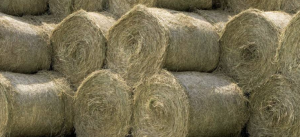
To stored hay in good condition, pay particular attention to the conditions where the bales are stored. Choose a spot that is dry and well-ventilated. If possible, make several smaller stacks of bales rather than one large stack; this allows air to reach more hay and minimizes the chance of mold formation. Storing hay in a covered building is best, but if no shelter is available, bales can be placed on pallets or frames that are raised four to six inches off the ground.
Cover outdoor hay with plastic or another protective material, but don’t wrap it so completely than air can’t circulate around the bales. Tarps or other opaque covers will keep the hay from being degraded by sunlight. Bales that are stored indoors can also benefit from being loosely covered to protect them from dust and animal droppings that can spread diseases to horses.
Feed the oldest hay first, mixing it with small amounts of newer hay and gradually increasing portions of newer bales until you use all the older supply. This is especially important if you are changing not just the cutting but the type of hay, as in switching from grass hay to alfalfa (lucerne) hay. A gradual change allows the microbial population in the horse’s hindgut to adapt to the new type of hay, avoiding gastrointestinal upsets.
Be sure hay was sufficiently dry before it was baled. Hay that is too damp is likely to mold, producing heat in the process that may be sufficient to cause a fire. Inspect each bale as it is fed, discarding any hay that is obviously moldy or has a musty or burned odor. A bale that feels significantly heavier than other bales in a particular batch of hay has a good chance of being damp and moldy.
Would you like more information about hay diets? Contact us at J & J Farms by clicking here!
Article brought to you by KER.
